By: Christina Lewis, Crenshaw High Special Education Teacher
Irvin Alvarado, Crenshaw High Alumni, Coalition for Educational Justice Organizer
Alex Caputo-Pearl, Crenshaw High Social Justice Lead Teacher, UTLA Board of Directors
Eunice Grigsby, Crenshaw High Parent, Crenshaw High Alumna
On October 23, Superintendent Deasy announced he intends to reconstitute Crenshaw High School. This scorched earth “reform” that is destructive for students, communities and employees has been used at Fremont, Clinton, Manual Arts and more, despite courageous push-backs at those schools. 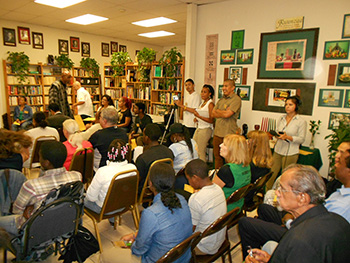
The Crenshaw school community is determined to fight back. The slogan that permeated the emergency 150-person Crenshaw Town Hall Meeting at the African-American Cultural Center on October 4 crystallizes the struggle — “Keep Crenshaw: Our School, Our Children, Our Community.”
In an attempt to disarm the push back and win public support, Deasy is combining the reconstitution with a full-school magnet conversion. Crenshaw stakeholders are, of course, open to conversations that will improve conditions and outcomes for our students — but those must be collaborative and well-resourced. That said, it is clear that Deasy’s main objective is not magnet conversion – it is to take top-down control of the school and reconstitute (which means removing all faculty and staff from the school, with an “opportunity to re-apply”).
The school community says NO to any form of reconstitution, and YES to school improvement that includes stakeholders and holds LAUSD accountable for its years of neglect and mismanagement.
In this spirit, teacher, parent and administrative leaders of Crenshaw’s nationally-recognized Extended Learning Cultural model have been reaching out to Deasy to work in collaboration for over a year and a half. He has not responded. It’s clear that Deasy has cynically set Crenshaw up – persistently ignoring calls to meet when it is about something locally-developed and progressive; later, acting as if nothing is happening at the school, and dropping the reconstitution bomb.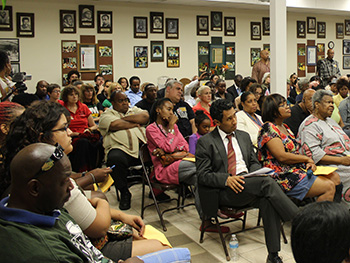
The Extended Learning Cultural model has been developed at Crenshaw over the last several years. The approach is to teach students standards-based material wedded with cognitive skills used in real life efforts to address issues at school, in the community, and with local businesses. Cultural relevance, Positive Behavior Support, parent/community engagement and collaborative teacher training and excellence are foundations of the program. Students engage in rigorous classroom work, as well as internships, job shadowing, leadership experiences, school improvement efforts and work experiences.
The Extended Learning Cultural model is fundamentally about extending the meaning, space and time of learning, and extending the school into the community and vice versa. This rooting of learning into a context is essential for students who have been constantly uprooted and destabilized by economic injustice and a school system that focuses on narrow test-taking rather than cultural relevance. Extended Learning could be enhanced dramatically for our students with LAUSD support. Instead, by threatening it, Deasy is jeopardizing Crenshaw’s progress, outside partnerships and outside funding.
Moreover, the Extended Learning Cultural model is supported by research – it draws from the Ford Foundation and various progressive academics’ national More and Better Learning Time Initiative, and it has been developed at Crenshaw with USC, the Bradley Foundation and other nationally-recognized research partners.
In contrast, the research shows that reconstitutions are not good for students. Reconstitutions cut students off from the faculty and staff they know, from programs they are involved in and from the communities surrounding their schools. Districts reconstitute schools in working class communities of color, creating more instability and uprootedness for students who are often our most vulnerable. Reconstitutions are educational racism. For more details, see a brand new study from UC Berkeley and the Annenberg Institute at Brown University at http://nepc.colorado.edu/files/pb-turnaroundequity_0.pdf.
Extended Learning showed results at Crenshaw in its first year of partial implementation, 2011-2012, after 2 years of planning. Crenshaw dipped on some indicators between 2009 and 2011 when the school had a principal who wasn’t the first choice of the selection committee, who was imposed by LAUSD, and who did not work collaboratively. However, when the school regained focus around Extended Learning in 2011-2012, the data showed growth, including:
- Meeting all State of California API growth targets except for one, often far exceeding the targets (for example, a 92 point API gain among special education students);
- Reducing suspensions and expulsions;
- Achieving substantial growth among African-American students on the API, reaching API levels significantly higher than African-American students at many other South LA high schools;
- Achieving an explosive increase in math proficiency levels among Limited English Proficient students on the CAHSEE;
- Achieving a huge jump in proficiency levels in CST math among all 10th graders;
- Including many more students in internships and work experiences;
- Organizing more partnerships for wrap-around services for students;
- Increasing parental involvement
Yet, Superintendent Deasy wants to disrupt this trajectory of growth and reconstitute Crenshaw. Worse yet, he wants to do this without any consultation with the community, parents, students, alumni, faculty and staff. Part of his agenda is to curry favor with the national scorched earth “reform” movement. Another part is straight union-busting. He has said many times he doesn’t like the teacher union leadership at Crenshaw – many of the very leaders who have been at the forefront of building the Extended Learning Cultural model, its national connections, and the growth that has come from it.
Not surprisingly, other schools that have been reconstituted in LAUSD have undergone “re-application” and “re-hiring” processes that have been shady – unrepresentative hiring bodies, discrimination against older staff and teachers of color, and discrimination against staff based on political issues.
The Crenshaw school community has a strategy to win the push back against Deasy’s reconstitution and to win support for the Extended Learning Cultural model and other enhancements:
- Amidst Deasy’s intense destabilization efforts that affect the school daily, educators, staff, and parents are working with site administration to tighten up school operations as much as possible;
- The school community is deepening, refining, and broadening engagement around the Extended Learning Cultural model;
- Faculty and staff have strongly solidified against reconstitution internally;
- School stakeholders are building on years of work with a unique coalition of community partners to organize parents, students, alumni, and community. This coalition includes Ma’at Institute for Community Change; African-American Cultural Center; Black Clergy, Community, and Labor Alliance; Coalition for Black Student Equity; Labor/Community Strategy Center; Coalition for Educational Justice; Sierra Club; Southern Christian Leadership Conference; Park Mesa Heights Community Council; and more.
- The coalition is working closely with UTLA. The House of Representatives voted unanimously to support the Crenshaw struggle. UTLA West Area and Progressive Educators for Action (PEAC) are critical supports for the ongoing organizing.
At the moment, the organizing will focus on the two places Deasy needs to go with his destructive plan for approval – the LAUSD School Board and the California Department of Education (Deasy cannot undermine Crenshaw’s federal School Improvement Grant, SIG, without communicating with Sacramento, because the grant is administered by the State).
The Crenshaw school community knows that the eyes of the city, state, and nation are watching Crenshaw. If Deasy gets his way at Crenshaw, it further opens the door to these kinds of moves everywhere – including places he’s already attacking locally with similar reconstitution efforts, like King Middle School, and far more. On the other hand, if Crenshaw is able to organize with school and community to push back on Deasy and to further advance a deep and hopeful educational and racial justice-based reform, its reverberations will be felt incredibly widely. Keep connected to the struggle and “like” us through the Facebook page – Crenshaw Cougars Fighting Reconstitution – and be in contact with us through email at [email protected].









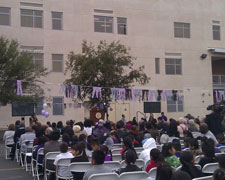
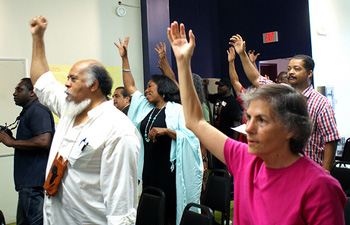 Rosalie Peterson of the Department of Neighborhood Empowerment raises her fist in the Community Issues Forum’s introductory Harambee chant.
Rosalie Peterson of the Department of Neighborhood Empowerment raises her fist in the Community Issues Forum’s introductory Harambee chant.  Moderators Carlos Montes and Maulana Karenga analyze a participant’s comment before responding to his question.
Moderators Carlos Montes and Maulana Karenga analyze a participant’s comment before responding to his question. 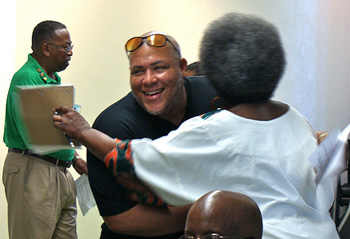 Two participants in the South L.A. Power Coalition’s forum greet each other with a handshake and an embrace.
Two participants in the South L.A. Power Coalition’s forum greet each other with a handshake and an embrace. 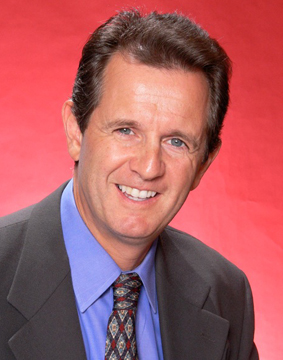 When teachers are accused of misconduct, sometimes we’re outright fired or placed in “rubber rooms,” a.k.a. teacher jail. According to LAUSD District policy (Bulletin-5168.0), if no impropriety is discovered, we’re supposed to return to our assignment within 120 days. Yet teachers routinely languish away in rubber rooms for years while the District places blame for this exile on the time it takes to conduct police investigations.
When teachers are accused of misconduct, sometimes we’re outright fired or placed in “rubber rooms,” a.k.a. teacher jail. According to LAUSD District policy (Bulletin-5168.0), if no impropriety is discovered, we’re supposed to return to our assignment within 120 days. Yet teachers routinely languish away in rubber rooms for years while the District places blame for this exile on the time it takes to conduct police investigations. You probably used to hear it from your parents all the time.
You probably used to hear it from your parents all the time. Dear LAUSD School Board Members, Superintendent Deasy, Secretary Duncan, and President Obama,
Dear LAUSD School Board Members, Superintendent Deasy, Secretary Duncan, and President Obama,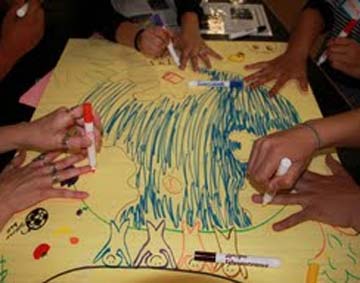
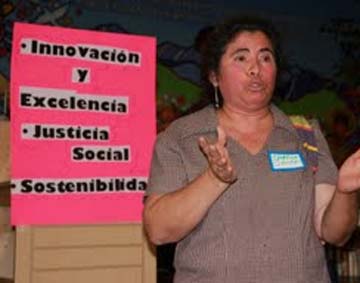
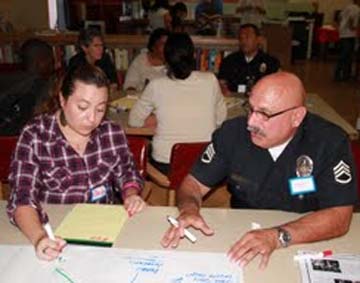
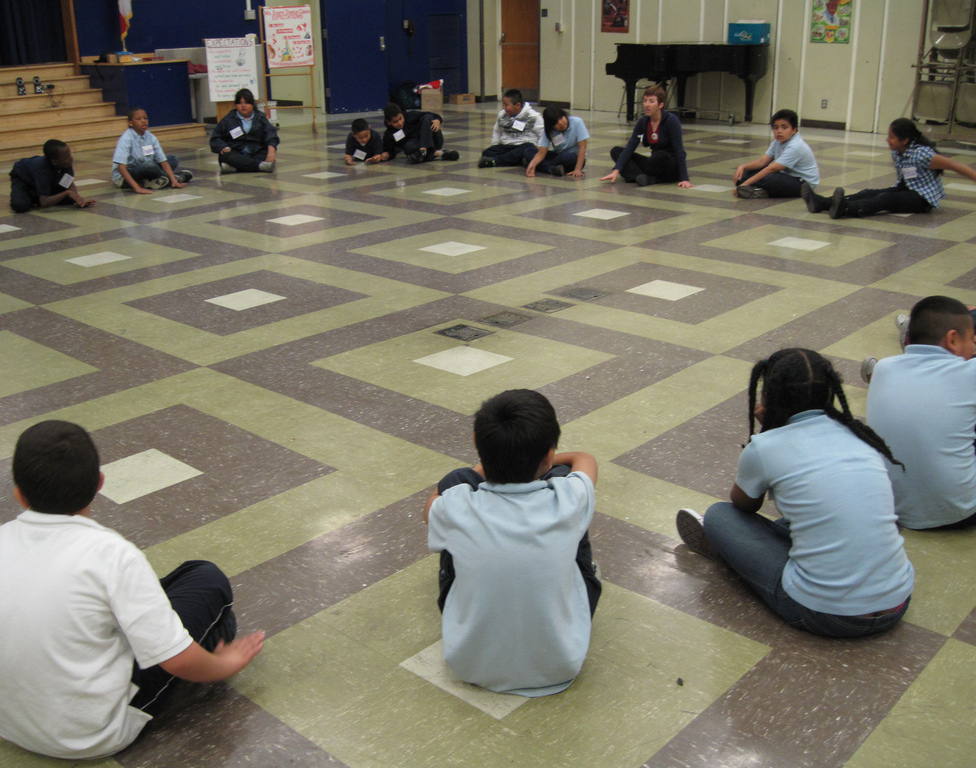 Shana Habel is the Dance Demonstration Teacher for the LAUSD Arts Education Branch. She has been with the program since its inception in 1999.
Shana Habel is the Dance Demonstration Teacher for the LAUSD Arts Education Branch. She has been with the program since its inception in 1999.




